Abstract
The focus on maintenance actions in the early design phases has been a trend in recent years. The main sources of information during the design of the maintainability process include operator reports, maintainer experience, failure history, and manufacturer recommendations. During this process, an important aspect is related to the configuration of maintenance tasks and interventions, such as their main phases, activities, and durations. The allocation or estimation of maintainability involves identifying and/or estimating the mean time to repair (MTTR) for each component or system. The time of the maintenance tasks or the repair time are fundamental for companies, as the availability of equipment directly depends on this parameter. In this study, a new method for evaluating maintainability during the design phases is proposed. The method is based on the integration of the maintenance task analysis (MTA) principles and the UNE 151001 maintainability evaluation standard. A data structure is proposed that serves the application of the UNE151001 procedures, obtaining a data-based maintainability evaluation. As a validation procedure, an application of the proposed approach is presented using two overhead cranes. Comparisons and recommendations are made regarding the maintainability of both pieces of equipment. Finally, some managerial and engineering insights are presented.
1. Introduction
Maintainability is a crucial metric in asset management, serving as a pivotal link between the availability of assets and operational efficiency [1]. It refers to the ease and speed with which an asset can be maintained or repaired, directly impacting its availability for use and overall productivity [2]. A high maintainability ensures minimal downtime, enhances asset reliability, and reduces operational costs, leading to improved efficiency in operations. It requires a strategic approach to design, regular maintenance planning, and the integration of feedback loops for continuous improvement. By prioritizing maintainability, organizations can significantly enhance their operational efficiency, ensuring that assets remain available and perform at optimal levels, thereby supporting sustainable and profitable operations.
Most of the existing methods and instruments for evaluating maintainability are qualitative in nature, utilizing expert judgments or virtual visualizations. This is the case with the UNE151001 standard, which is primarily based on qualitative assessments of attributes related to maintainability. With the greater availability of data, it is now possible to incorporate quantitative aspects into this analysis. The main objective of this work was to propose a methodology that allows the evaluation of the maintainability attributes of industrial equipment based on the integration of the principles of the maintenance task analysis (MTA) and the UNE 151001 standard [3]. For this integration, a database generic structure is proposed that contains information to perform the MTA and support the maintainability evaluation process based on the aforementioned standard [4]. The proposed methodology includes a maintenance task analysis (MTA) supported by data on the expected or historical durations of maintenance activities, as well as the technical and human resources utilized. Using such data and considering a set of maintainability attributes proposed in the UNE 151001 standard, a semi-quantitative maintainability assessment was performed. To validate the methodology, a set of tasks on two existing pieces of equipment with different configurations were analyzed, allowing for the comparison of the maintainability indicators relative to each design.
The paper is organized as follows: in Section 2, a brief literature review is presented, which has been subdivided into two main parts: the UNE 151001 standard and the maintenance task analysis. Subsequently, in Section 3, the proposed methodology is presented. To validate the proposal, a case study based on two existing overhead cranes in an electric generation plant is provided in Section 4. Finally, the conclusions of this work are presented in Section 5.
2. Brief Literature Review
The maintainability of industrial equipment is defined by its ability to undergo maintenance or repairs efficiently, safely, and effectively, ensuring availability at the lowest possible time, cost, and effort [2]. It encompasses the ease of diagnosing and fixing failures, the simplicity of carrying out preventive and corrective maintenance tasks, and the quick restoration to operational status post-downtime or malfunction. Maintainability is critical in industrial equipment design and operation, as it directly affects the operational efficiency, maintenance costs, and workplace safety [5]. Enhancements often require reengineering, additional investment, and occasionally, changes to the operational context. The maintainability analysis is a key tool for improving this attribute [6,7].
The mean time to repair (MTTR) is a widely used quantitative metric for maintainability, calculated using statistical data on the duration of repairs [8]. The time needed to diagnose and repair can be influenced by multiple elements defined in the initial design stages [9]. These factors can be categorized into two groups: internal or inherent to the system, and external, associated with the maintenance organization. These factors are depicted in Figure 1. For a detailed understanding of these factors, it would be essential to refer directly to the figure and the accompanying explanations in the source document.
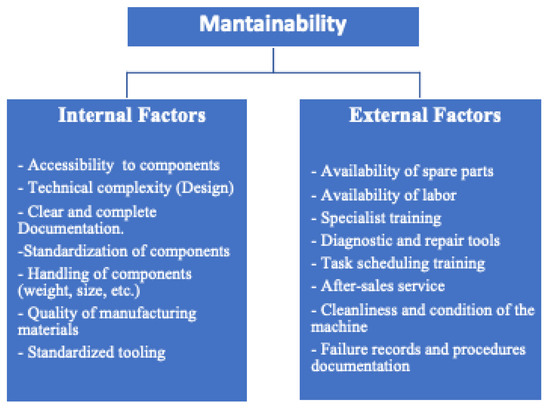
Figure 1.
Maintainability internal and external influencing factors.
However, studies suggest that maintainability metrics alone may not suffice for a precise maintenance effort estimation [10]. They recommend including factors such as design complexity and quality [11]. Some methods assess maintainability in complex systems through grouped maintenance–time distributions and specific indices [12]. Techniques such as stochastic colored Petri nets (SCPNs) simulate maintenance processes for performance metrics such as MTBF and MTTR, considering optimal maintenance strategies [13]. Proactive analytical methods utilize the failure mode and effects analysis (FMEA) for system reliability and efficiency [14]. Studies on mechanical systems in electric rope shovels and material handling machinery in mines indicate that factors such as equipment age and maintenance practices are vital for performance [15,16].
A significant challenge in the maintainability analysis is the lack of historical data for the new equipment, which hampers a conclusive statistical analysis. The current literature points towards a proactive maintainability evaluation and design using advanced technologies to foresee and address issues, enabling maintenance scenario simulation and predicting the impact of design changes. The adoption of digital tools is becoming a standard for optimizing maintainability from the early design stages, focusing on simulation [17,18] and augmented reality to pinpoint potential issues and enhance maintainability [19]. Digital twin technology and virtual reality are also emerging as effective methods for testing and improving maintainability in secure, controlled environments [20,21]. Augmented reality and digital twins exemplify such technologies [22]. Such technologies facilitate early issue identification and maintainability-focused design optimization [23,24]. AI and machine learning are increasingly used to analyze IoT device data for predictive maintenance. Techniques incorporating uncertainty, such as fuzzy logic, are gaining importance in the maintainability analysis [25,26]. Despite the use of various technologies for the evaluation of maintainability, these assessments still have a largely qualitative character and are not based on data from historical records of similar equipment or mockups.
2.1. UNE 151001 Standard
The UNE 151001 standard is a Spanish technical standard that outlines a general procedure for obtaining maintainability indicators for industrial devices. It is applicable across all types of industrial devices and is versatile for various situations, including system comparisons, device design improvements, specific industrial environment maintainability evaluation, and foreseeing maintainability issues due to device location changes. It can be applied during both the preparation and operation phases of a device, emphasizing the importance of specifying the lifecycle stage and the device’s usage and environmental conditions for meaningful and comparable measurements [27]. The indicators quantify the maintainability performance.
The maintenance actions are divided into five levels based on complexity: Level 1 is simple maintenance performed while the device is operating; Level 2 involves replacing components with the device shut down; Level 3 is diagnosing failures; Level 4 is inspections and tests; Level 5 is major overhauls and modifications.
Two sets of attributes are used to assess maintainability:
- Eight general attributes that apply to any maintenance level (e.g., simplicity, accessibility)
- Nine specific attributes that depend on the maintenance level (e.g., tools required, documentation)
The attributes are scored on a 0–4 scale by experts. The scores are combined using a weighted average to calculate:
- An overall maintainability indicator
- Five maintenance level-specific indicators
The method allows the consideration of different weights for the attributes depending on the device and operating conditions. The indicators aggregate the attribute information in a practical way to assess and compare maintainability.
2.2. Maintenance Task Analysis
Since the initiation of the 20th century, great engineers and researchers such as Taylor, with his scientific management theory that simplifies tasks into basic elements; Fayol, who set his fourteen principles emphasizing specialized labor for greater efficiency; and Weber, with his bureaucratic theory for managing complex organizations most efficiently, continue to shape modern managerial thinking and organizational practices [28,29]. More recently, in the context of Lean and the Toyota Production System, the paper by Bowen and Spear [30] proposed four principles/rules that outline how Toyota sets up its operations as experiments under the principles of the scientific method. Notably, rule number one states that: “All work shall be highly specified as to content, sequence, timing, and outcome”. From this foundation, and drawing inspiration from the aforementioned principles, the maintenance task analysis (MTA) has emerged as a systematic process utilized in maintenance engineering and asset management [31]. Its goal is to ensure the operability and reliability of equipment throughout its lifecycle by identifying, analyzing, and documenting the necessary maintenance tasks [32]. It is crucial for creating efficient maintenance plans, optimizing resources, and reducing downtime [33]. The maintenance task analysis (MTA) involves identifying and documenting all the maintenance efforts, activities, and actions necessary to maintain, change, improve, or restore the functionality of an element under specific operating conditions [34]. Alternatively, it serves as a basis for maintainability prediction models by collecting maintenance task data [35]. Also, the MTA is conducted early in the asset design phase and should be reviewed as design changes occur [1].
The main goals of the MTA are to identify all the tasks needed to maintain the equipment in an optimal condition, perform maintenance with minimal resources, prevent unexpected failures, and comply with regulations and standards [36]. The process involves breaking down the system into subsystems and components for a detailed analysis, listing the necessary tasks for each component (including preventive, corrective, and predictive maintenance), determining the frequency of these tasks, and identifying the required resources, such as tools, spare parts, and labor needs. It also includes documenting specific procedures for each task, allowing for the estimation of their duration times, as well as assessing risks and proposing mitigation measures [34].
3. Proposed Methodology
This proposal aims to establish a robust and efficient methodology to complement the use of the evaluation of the maintainability attributes according to the UNE 151001 standard with an MTA-based approach. To this end, a data structure is proposed that enables the capture of information to approximate this analysis using a more quantitative method, with time data for the main identified or planned maintenance tasks. The process begins with gathering the maintenance data from historical records and the technician’s expertise to form a foundation for further maintainability attribute evaluation. The maintainability attributes are identified and defined according to the UNE 151001 guidelines. To streamline the evaluation process, a set of mathematical relations is defined to integrate the analysis and the attribute assessment process. Finally, a visualization system is proposed to facilitate the interpretation and effective communication of the maintainability assessments, supporting informed and prompt decision-making. Figure 2 shows a diagram of the proposed methodology.
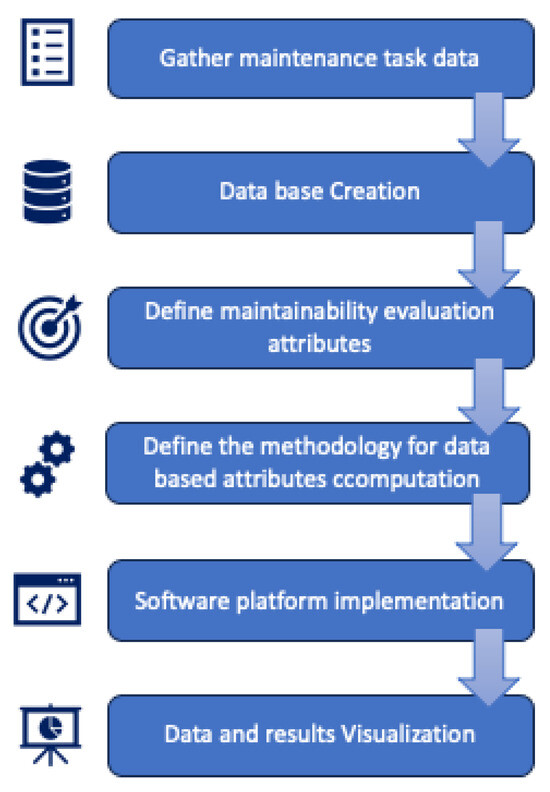
Figure 2.
Proposed methodology.
The precise collection of data is crucial for optimizing management and process efficiency. For detailed information on maintenance, one can utilize various sources, including manufacturer documentation, maintenance activity logs, historical data, and feedback from maintenance personnel. By integrating these sources, a more comprehensive view is achieved, which enhances the analysis and consequently aids in process optimization. This holistic approach not only allows for a deeper understanding of the maintainability attributes but also supports informed decision-making for the implementation of effective continuous improvement strategies.
3.1. Data Structure
In order to guarantee the correct organization of the information related to the maintenance activities and interventions, and thus facilitate the searches and subsequent calculations related to the maintainability analysis, a customized data structure was defined for containing and providing the information required by the maintenance task analysis (MTA) worksheets. Furthermore, this database prototype was carefully designed to facilitate a seamless integration with the existing business analytics service platforms available in the market, such as the Power BI system. The defined tables (and their fields) are as follows:
Maintenance Tasks: Table 1 summarizes the different maintenance activities carried out on various equipment.

Table 1.
Data structure of the maintenance activities.
Plant Equipment: Table 2 contains information about the plant equipment, along with key information on the equipment used in a facility.

Table 2.
Data structure of the equipment.
Components: Table 3 contains a detailed record of the individual elements that make up each piece of equipment in the plant.

Table 3.
Data structure of the components information.
Task Analysis: Once the task performed on the asset is defined, each activity within that task must be defined and related. This involves examining each step that the maintenance team must perform. Each step of the task must be identified with a unique number, along with a description of the task and the defined time (Table 4).

Table 4.
Data structure of the tasks description.
Personnel Skills: To determine the level of personnel carrying out the maintenance activities, they are defined in Table 5. These levels are subject to changes according to the needs and availability of the analyst.

Table 5.
Data structure of the different workforce skills.
Parts Required per Task: Table 6 records the spare parts required for each maintenance task. It is necessary to define what is needed to carry out the task in terms of spare parts, supplies, etc. This is crucial as it will feed into the inventory requirements. It defines the specific components required for each step, along with the necessary quantities in the particular case.

Table 6.
Data structure of the required parts or components for each task.
Tools per Task: Table 7 records which tools or support equipment will be necessary to perform each step. This includes manual tools, power tools, test benches, load lifting equipment, electronic tools, etc. Each tool or piece of support equipment must be defined with the required number and description along with any specifications, for example, the capacity of a hoist, along with the estimated time of use per task. This allows the determination of the amount of equipment and tools needed to support the operation.

Table 7.
Data structure of the required tools for each task.
Master Tool: This table contains a list of the tools available for different maintenance tasks, which is useful for managing resources and ensuring that the right tools are available when needed (Table 8).

Table 8.
Data structure of the master tool table.
Master Spare Parts Table: Table 9 contains a list of the general spare parts available for different maintenance tasks, which is essential for maintaining an organized inventory.

Table 9.
Data structure of the available spare parts or components for each task.
Documents Table: Table 10 records information about the documentation relevant to the maintenance activities, which may include manuals, diagrams, blueprints, procedures, technical specifications, etc., during an analysis of the maintenance area are the documentation requirements.

Table 10.
Data structure of the documentation required.
With the complete definition of all the data tables, a model focused on the maintenance tasks is structured, as illustrated in Figure 3, in which each table is connected to another through a relationship between them.
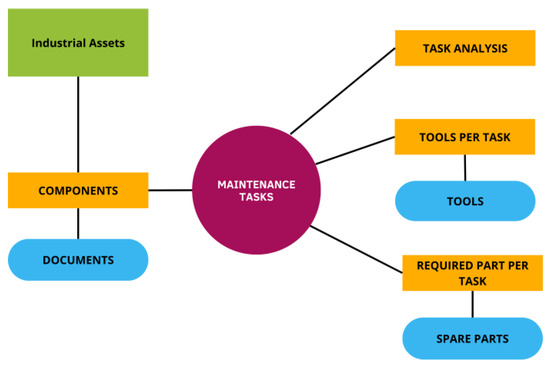
Figure 3.
Proposed data structure.
3.2. Maintainability Attributes
As mentioned earlier, the selection of attributes for the analysis of the maintainability indicator has been based on the UNE 151001 standard. Therefore, from the set of eight general indicators and the nine attributes per level suggested by the standard, a set of eight attributes was selected, as follows:
- Accessibility
- Staff training
- Staff organization
- Standardization
- Spare parts
- Tools and equipment
- Site/location
- Assembly and disassembly.
This selection of attributes provides a solid foundation for evaluating maintainability, covering key aspects that impact the system’s ability to be maintained effectively and efficiently. A maintenance activity is defined as each step within a task. For each maintenance task, the associated activities will be subdivided into three different groups. The 3 groups are:
Access Activities: This group includes all activities related to gaining access to the machinery or equipment that requires maintenance. This could include access to high areas, work platforms, assembly of scaffolding for difficult-to-reach areas, transport, and use of lifting equipment. Access tasks are essential to reach the areas that require attention but do not directly involve the repair or maintenance of the parts themselves.
Operational Activities: This group includes the preliminary tasks performed by the operations area; it focuses on activities related to equipment lockout. Equipment lockout is a crucial procedure to ensure safety during maintenance tasks, here all activities related to the preparation and application of lockouts are included, as well as the verification that the equipment is completely de-energized and safe before performing any maintenance task.
Service Activities: This group refers to the actual maintenance activities. It includes all tasks aimed at maintaining, repairing, or replacing specific components of the machinery or equipment. These tasks often involve temporarily stopping the equipment to perform maintenance safely and effectively. This could include lubrication, adjustments, replacement of worn parts, calibration, among others.
Each of these groups breaks down maintenance activities into specific categories, which will help to define the stages of time use in the activity performed.
Therefore, the execution time of a task is:
where
ttask is the total time of the task.
taccess is the total time of access activities.
toperations is the total time of operational activities.
tservice is the total time of service activities.
3.2.1. Accessibility Attribute
The valuation of the accessibility attribute is carried out by establishing a relationship between the total time dedicated to maintenance and the time specifically spent on the tasks related to access.
where Taccess is the percentage relationship between the time spent accessing the equipment and the total time of the task.
This valuation tends to be higher when the percentage of time dedicated to access during a task is lower. This is because, under these circumstances, the accessibility to the component to be intervened is better. Conversely, when the percentage of time dedicated to access is higher, the valuation of the accessibility attribute tends to decrease, since the accessibility to the component to be intervened is compromised. The values assigned to each percentage are detailed in Table 11. These values are based on the author’s criteria and are subject to change according to requirements.

Table 11.
Accessibility values.
3.2.2. Staff Training Attribute
To value the staff training attribute, one must consider the time dedicated by the personnel to both the access and service activities, since both directly affect the execution of the task in question. This aspect, having a significant impact on the development of the task, is fundamental for the evaluation of the efficiency and performance of the involved personnel. When the majority of the required time is allocated to initial-level personnel, the maintainability is considered to be high. In this scenario, it is not necessary to have highly qualified personnel, which facilitates the execution of the task. On the contrary, when the intervention of expert-level personnel is required, it is interpreted as a sign of low maintainability, since it implies dependence on specialized professionals to carry out the task. This indicator underscores the complexity and specialization required, affecting the overall effectiveness of the process. Therefore, the ratio of manhours (MH) at one level relative to the total manhours must be obtained.
In Table 12, the relationship between manhours and the attribute value for each of them is established. These values are flexible and subject to change according to the needs of the evaluator.

Table 12.
Manhours required by the task and the attribute values.
3.2.3. Staff Organization Attribute
The staff organization attribute considers the number of human resources used during the service activities and access activities. This is expressed as:
where:
- , is the average number of workers involved in the maintenance task.
- , is the total manhours during the task.
- , is the manhours dedicated exclusively to operational activities during the task.
- , is the total task time.
- , is the total time for operational tasks.
This calculation provides a ratio that reflects the average number of personnel during the execution of tasks. Then, the value obtained is used to assign a staff organization attribute value according to Table 13. These values have been assigned based on the scale present in the UNE151001 standard and can be adjusted according to specific requirements.

Table 13.
Values of the personnel organization attribute.
3.2.4. Standardization Attribute
To assign a value to the standardization attribute within a task, a detailed analysis of each spare part that will be used during the maintenance task is carried out. This process involves verifying how suitable the component options available in the market are for replacing the current component. The goal is to minimize the storage of parts and reduce the need for adjustments, especially in elements that will be replaced during the lower-level maintenance stages. The assignment of a standardization value to each spare part is governed by the criteria defined by the UNE 151001 standard, as detailed in Table 14. These criteria provide a clear and specific guide for evaluating the degree of standardization of each component, facilitating consistency in the evaluation.

Table 14.
Values of standardization attribute.
3.2.5. Spare Parts Attribute
To define the spare parts attribute, the requirements related to the storage and handling of the spare parts of the component to be serviced are evaluated. Inventory management can vary significantly depending on the types of products being stored. To assign a spare parts attribute value to each inventory item, an evaluation matrix is used (Table 15) in which the storage requirements and handling requirements must be defined.

Table 15.
Storage requirements and handling requirements in the spare parts attribute.
The inventory storage requirements refer to specific conditions that must be met to ensure the integrity, safety, and quality of the stored products. Some of the special inventory storage requirements that could apply, depending on the nature of the products, are detailed in Table 15. These requirements may include specific conditions such as temperature, humidity, lighting, or any other relevant factor to ensure the integrity and optimal functionality of the stored products. Understanding and applying these requirements are essential to ensure the quality and availability of products in the inventory. Inventory handling refers to the set of activities related to the physical movement and handling of products stored in an inventory. It involves processes ranging from the receipt of goods to their storage, picking (selection of products for shipment), packing, shipping, and, in some cases, returns. Table 15 classifies the levels of inventory handling into easy, medium, and difficult. Each level has associated typical characteristics that could help to classify the requirements and challenges involved in each. It should be noted that this table is general and may need adjustments according to the specific needs.
3.2.6. Tools and Utilities Attribute
To assign a value to the tools and utilities attribute required for a maintenance task, a detailed evaluation of the necessary tools to carry out each activity effectively and safely must be performed. Table 16 presents a matrix with which each tool is evaluated and then a value is assigned to the attribute. This assignment is made based on the analyst’s criteria and can be modified according to the needs.

Table 16.
Easiness of acquisition and specificity characteristics in the tools attribute.
To define a value for the attribute at the task level, the following must be considered:
- Tools must have their attribute valued
- The usage time of the tool, which is verified or estimated in the MTA
- If the use of tools is not specified in any activity, it is assumed that standard tools for different tasks are used, for which the highest value (4) is assigned
- A value is calculated by weighting the value of the attribute of each tool in relation to its use in the task
Therefore, the tools and equipment attribute value for a task is defined by:
where:
- , is the usage time of a tool
- , is the tool and utility attribute value of a tool
- , is the service activity time during which no specific tools are used
- , is the service activities time
3.2.7. Site/Location Attribute
The environment attribute is closely related to the necessary conditions to carry out the maintenance tasks safely and effectively. The assignment of a value to this attribute is based on an analysis of the possible risk conditions that could arise during the execution of the task. Table 17 shows a progressive decrease in the attribute value as the number of identified risk conditions increases.

Table 17.
Values of site/location attribute.
Some potential risk conditions include:
- Electrical arc potential
- Risk of impact from objects
- Working at height
- Handling of hazardous substances
- Lifting and rigging
- Activities near stored energies
- Proximity to rotating equipment
- Confined spaces
- Hot work
- Tasks in explosive areas
Conducting specific assessments for each task is essential to determine the associated level of risk and to implement appropriate preventive measures. The training of personnel in the identification and management of specific risks plays a crucial role in ensuring a safe work environment and in the successful execution of the maintenance tasks.
3.2.8. Assembly and Disassembly Attribute
To determine the value of the “assembly and disassembly” attribute, it is necessary to define which activities within a task correspond to the assembly and disassembly. Subsequently, a detailed analysis of each step is carried out, calculating the percentage of assembly and disassembly activities in relation to the total time of the task.
where is the percentage ratio between the time spent on the assembly and disassembly activities and the total time of the task. With this percentage, a value is assigned to the attribute according to Table 18. These values are based on the author’s criteria and are subject to change according to requirements.

Table 18.
Value of the assembly/disassembly attribute.
This approach allows identification and quantification of the complexity associated with the assembly and disassembly activities. In situations where the assembly occupies a significant percentage of the total time, it is deduced that these tasks are more complex and require more effort and attention.
3.3. Proposed MTA and Quantification Example
To exemplify the application of the maintenance task analysis using the proposed database, the following case study is presented.
The task corresponds to Level 1 of the UNE 151001 standard, implying lubrication without causing equipment unavailability. The selected task involves the lubrication of a steel cable on a 16-ton capacity, 5-m-high overhead crane located in the water pump area for the boiler feed at a coal-fired power plant. To carry out this task, a specialized work team is required, consisting of one worker who is responsible for lubricating the cable and an operator in charge of operating a manlift, which is used to access specific points of the overhead crane. This task record is shown in Table 19. The component associated with the task is defined in Table 20. The details of the maintenance task analysis for the lubrication of the steel cable are shown in Table 21. During the task, the manlift needs to be transported to the work area by the operator (intermediate-level personnel). Once in the area, the person in charge of lubrication (initial-level personnel) can access the drum containing the equipment’s cable for maintenance. The work is carried out with the equipment energized, so there is only a stoppage when accessing the drum. The task does not require a component replacement. However, as a preventive measure and to ensure continuity without interruptions, backup bolts for drum protection anchorage will be available to the worker if necessary. The set includes six M6 × 15 mm bolts, which are recorded in Table 22. The time required for each tool or the support element needed for the task is defined. Throughout the task, the manlift is used as a support element, and there is no requirement for the special tools (Table 23).

Table 19.
Data structure of the maintenance activity: cable lubrication.

Table 20.
Data structure of the component: steel wire.

Table 21.
Task description, timing, and human resources skills.

Table 22.
Data structure of the required component: metric bolt.

Table 23.
Data structure of the required manlift.
4. Validation Study
This section outlines the proposed methodology as part of the effort to validate it and demonstrate its feasibility. Two bridge cranes are considered, which present significant differences in terms of their capacity, configuration, and age of manufacture. Despite this, both perform the same essential function in an actual industrial plant, generating a similar impact on its operations. These pieces of equipment are located in a coal-powered thermoelectric facility. They are associated with different generating units and are part of the area responsible for operating in the seawater intake installations. Both cranes play a fundamental role in the operational efficiency of the complex, contributing significantly to the process of filtering and pumping seawater, which in turn supports the optimal functioning of the facilities in general. Table 24 presents the main characteristics and information of both cranes. Figure 4 shows the equipment A, a 25-ton gantry type overhead crane. The Figure 5 shows the equipment labeled as Equipment B, a 13.5-ton overhead crane.

Table 24.
Main data for both equipment.
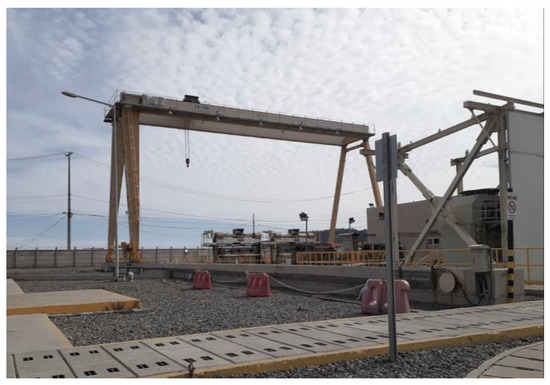
Figure 4.
Equipment A: 25-ton gantry-type overhead crane.
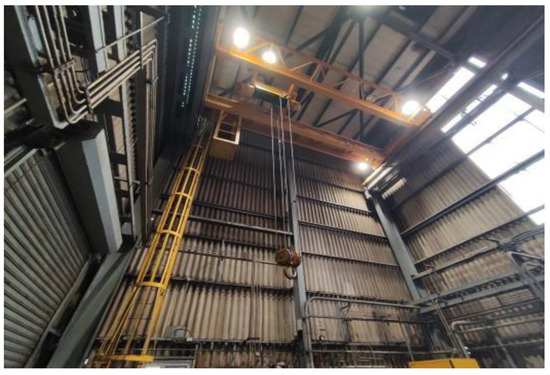
Figure 5.
Equipment B: 13.5-ton overhead crane.
4.1. Comparison of Indicators
A comparison of the maintenance indicators for the four different tasks applied to both pieces of equipment is made. These tasks have been selected for being frequent in the field of lifting equipment maintenance and also for having practical knowledge of their execution.
4.1.1. Task No. 1: Replacement of the Steel Wire Rope for Lifting
The replacement of the steel wire rope on a bridge crane is carried out when it no longer meets the proper conditions for safe operation. All the steel wire ropes in service must be constantly observed during operation to verify their behavior. The presence of wear, broken wires, crushing, diameter reductions, cable elongation, corrosion, distortion of the core, splices, and terminals must be evaluated. The criteria for considering a wire rope as unsafe for operation on cranes are defined by ASME B30 standards.
Additionally, when the equipment is in constant operation and hinders the performance of inspections and maintenance tasks, it is considered good practice to establish a service time interval for the cable. Within this interval, regardless of its apparent condition, its replacement will be scheduled. This measure aims to mitigate the risk of potential cable failures due to fatigue.
To carry out the work, it is necessary to have work platforms that allow access to the anchoring points of both ends of each cable, one of them is anchored to a fixed point in the structure of the trolley and the other, which is mobile, is on the lifting drum. For this, scaffolding is assembled, which varies according to the disposition of the equipment. Once these scaffoldings are in place, the disassembly and subsequent assembly of the rigging are carried out. From the task analysis, we obtained the following results (Figure 6, Figure 7 and Figure 8):
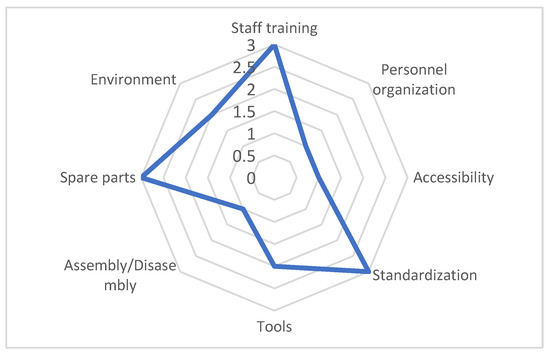
Figure 6.
Maintainability indicator for the steel cable replacement on Equipment A.
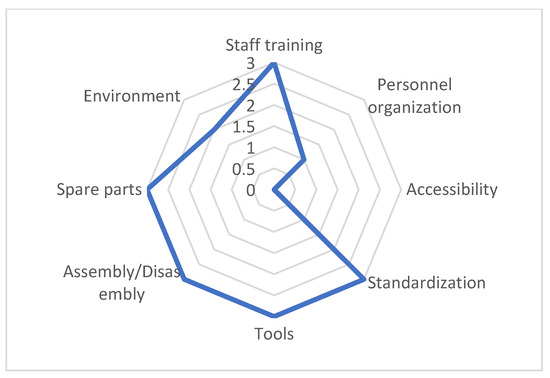
Figure 7.
Maintainability indicator for the steel cable replacement on Equipment B.
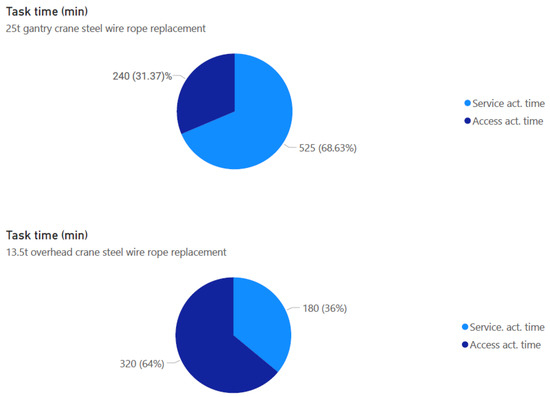
Figure 8.
Task time, change of steel rope cable on Equipment A and B.
From Figure 6, Figure 7 and Figure 8, the following is concluded: the greatest difference is observed in the assembly/disassembly attribute, which is explained by the greater complexity of the lifting system in equipment A compared with equipment B.
Equipment A has a hook with six pulleys and uses two different cables, in addition to being of a greater dimension than equipment B, which has two pulleys and uses one cable, leading to a much longer and more complex rigging process in the first case.
Regarding the aspect of tools, a lower level of maintainability is observed in equipment A compared with equipment B. Both require the use of scaffolding to reach the intervention points; however, in equipment B, there is the possibility of assembling a hanging scaffold from one end of the bridge. This method involves using a minimal number of special tools compared with equipment A, where the only option to access the work point involves building the scaffolding from the ground level. This latter approach not only increases the amount of material and tools needed but also prolongs the time required for scaffold assembly and tool transportation.
4.1.2. Task #2: Inspection and Adjustment of the Trolley Movement Brake
A periodic inspection and brake adjustment for the bridge translation is carried out. The proper functioning of these brakes is crucial for maintaining safe operations, as it prevents the undesired displacement of loads during operation.
This brake system employs an electromagnet, set up such that when the motor runs, the electromagnet is engaged, holding the brake shoes in an open position. This design allows the motor shaft to spin freely. When the motor disconnects from the power supply, the electromagnet disengages, allowing the opposing springs to apply pressure on the brake shoes. The shoes then press against a stationary plate on the motor shaft, instantly halting its rotation. This mechanism effectively stops the motor when necessary. Figure 9 shows the breakdown of a motor alongside its magnetic brake, as provided by the manufacturer.
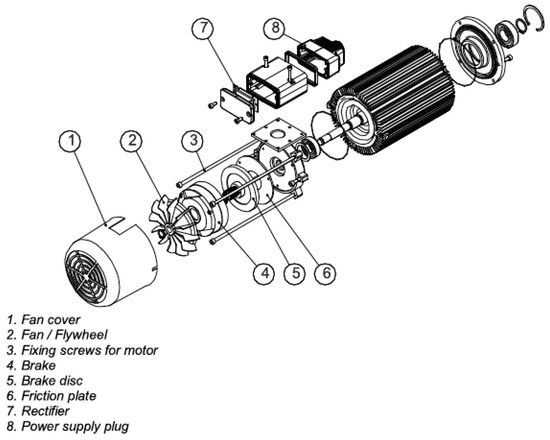
Figure 9.
Breakdown of the motor and magnetic brake.
The transmission system for the trolley movement has a different configuration in both cases. Equipment A has an individual transmission system, that is, a motor and gearbox for each wheel on an axle, and Equipment B has a central motor that transmits power to the wheels through a gearbox and axles. Figure 10a illustrates the arrangement of an individual motion transmission system and Figure 10b illustrates a central transmission one.
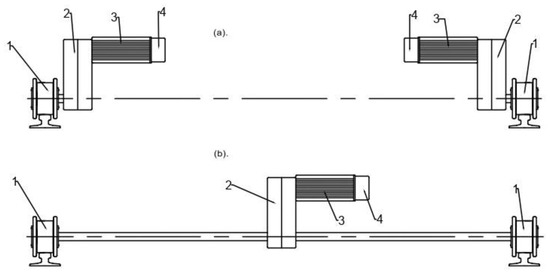
Figure 10.
(a,b) Motion transmission system. (1: wheel; 2: reduction box; 3: motor; 4: brake).
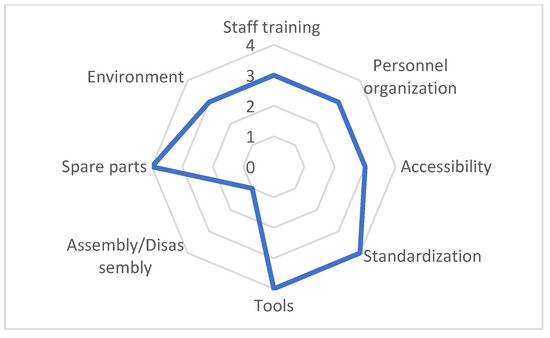
Figure 11.
Maintainability indicator for the task of inspection and adjustment of trolley translation brakes in Equipment A.
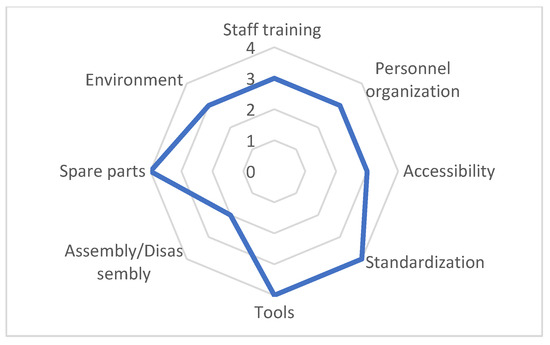
Figure 12.
Maintainability indicator for the task of inspection and adjustment of trolley translation brakes in equipment B.
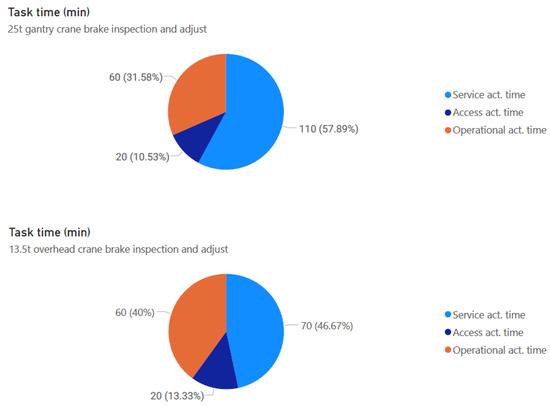
Figure 13.
Task time, inspection, and adjustment of brakes for trolley movement in Equipment A and B.
Despite the different arrangements of the trolley’s travel motors, the task is carried out in the same way on both pieces of equipment. In the case of Equipment A, this task takes more time because two motors must be inspected, while in Equipment B, only the single motor is inspected. This disparity explains the variation in the assembly and disassembly attribute.
4.1.3. Task No. 3. Replacement of Rails and Festoon Trolleys for Trolley Electrification and Hoisting System
It is crucial to keep both the rails and the festoon trolleys in an optimal condition to prevent blockages that could cause problems in the equipment’s electrification. To achieve this, it is necessary to maintain constant lubrication and carry out periodic inspections, especially in adverse or challenging environments. If blockages or jams are detected, that section must be changed immediately. This will ensure that the equipment continues to operate safely and efficiently. As a best practice, if blockages are a frequent occurrence or if access to the rails and festoon trolleys is complicated, it may be advisable to consider the complete replacement of these components. This can reduce the need for constant maintenance and improve the reliability of the system in the long term.
The festoon system follows a standard design that includes C-type rails through which the trolleys move (Figure 14). These rails can be made of various materials, selected according to the environmental conditions and the specific workload. To facilitate the assembly, the anchors and joints are secured with bolts. To perform the work, the electric power must be locked out since the cable will be handled directly.
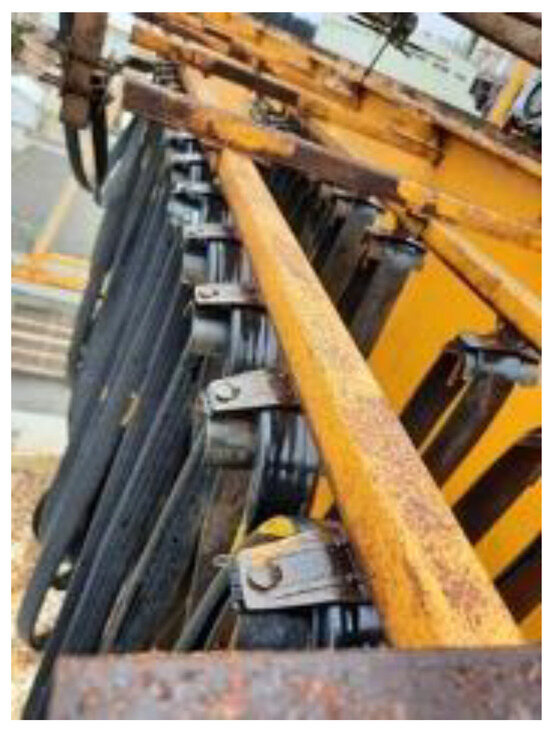
Figure 14.
Festoon cable and support structure.
From the task analysis, we obtained the following results (Figure 15, Figure 16, Figure 17, Figure 18, Figure 19 and Figure 20):
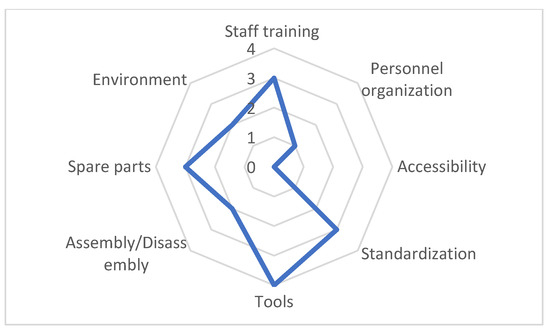
Figure 15.
Maintainability indicator, replacement of rails and festoon trolleys in Equipment A.
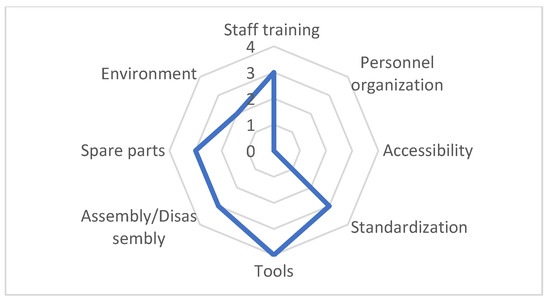
Figure 16.
Maintainability indicator, replacement of rails and festoon trolleys in Equipment B.
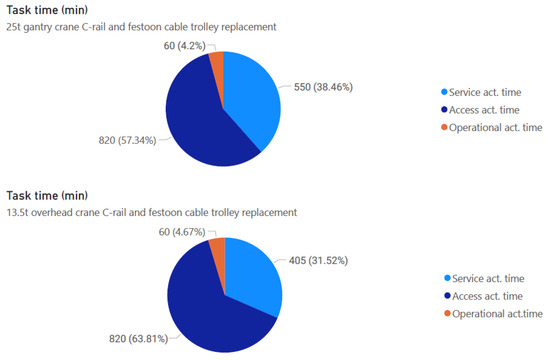
Figure 17.
Task time, replacement of rails and festoon trolleys in Equipment A and B.
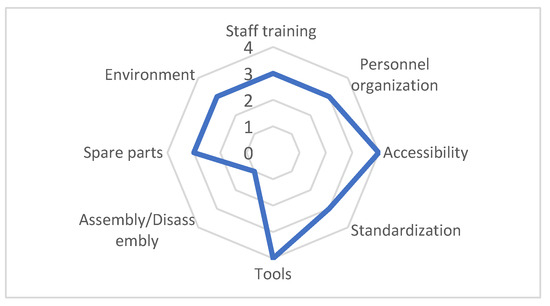
Figure 18.
Maintainability indicator for replacement of end-of-travel limiter on the crane in Equipment A.
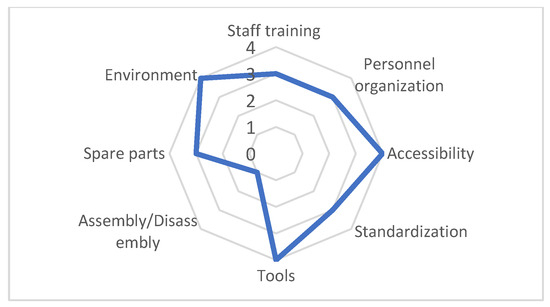
Figure 19.
Maintainability indicator for replacement of end-of-travel limiter on the crane in Equipment B.
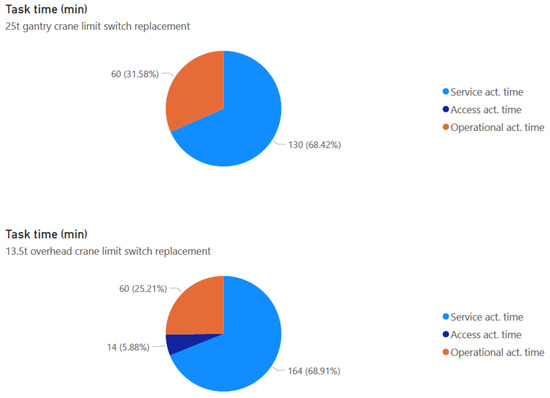
Figure 20.
Task time, replacement of bridge travel limiter in Equipment A and B.
The following conclusions are drawn:
Both pieces of equipment present similar access times, although their configurations differ significantly. This is due to the requirement to install scaffolding that spans the bridge’s span at the height of the festoon rails and their difference in the assembly process.
In the case of Equipment A, the gantry crane has a work platform that facilitates access to one end of the rail, serving as the starting point for the scaffolding assembly. On the other hand, for equipment B, the process involves starting the construction of the scaffold from the ground level up to the height of the work point, and then the work platform covering the total length of the rail is mounted. Although Equipment B has a shorter span, the complexity of the scaffolding is greater, thus leading to a higher demand for materials and labor. This disparity explains the difference in the attribute of personnel organization between both pieces of equipment.
Regarding the assembly and disassembly attribute, equipment A, being more extensive, will require more time compared with Equipment B.
4.1.4. Task No. 4. Replacement of the End-of-Travel Limit Switch for Bridge Trolley Movement
The end-of-travel limit switches on an overhead crane are located on the main beams of the crane, generally at each end. This device serves to stop and/or change the speed of the equipment’s movement once activated. A cross-type limiter is used for the equipment with two speeds, and a rod-type limiter is used for single-speed equipment. It is essential for the safety of the operation to prevent accidents and damage to the equipment caused by collisions with nearby structures.
It is important that the limit switches are kept in a good working condition and are regularly inspected as part of the preventive maintenance to ensure the safety of the operations. To carry out this task, the equipment must be de-energized, since an electrical component will be intervened. The accessibility depends on the configuration of the equipment, which is generally attached to one of the end trucks. Once the replacement is complete, its correct operation must be verified, and the relevant adjustments made. From the task analysis, we obtained the following results (Figure 18, Figure 19 and Figure 20). The parameters analyzed include staff training, environment, spare parts, personnel organization, accessibility, assembly/disassembly, standardization, and tools. Figure 18 and Figure 19 show small variations in these parameters. Considering that the safety of the site also plays a crucial role in the maintainability analysis, a safer environment with fewer risks and better compliance with safety regulations can contribute to a higher score. When comparing Figure 18 and Figure 19, this difference is evident. Equipment B, as a higher one, will result in more hazardous conditions for the maintenance interventions under analysis. These variations suggest that there are different maintenance needs and complexity between the two pieces of equipment, which in a way validates the analysis conducted and proposed.
As can be seen in Figure 20, the overhead crane has an additional access component that should be considered when planning or optimizing the maintenance process. The path to reach the overhead crane’s components might be more complex, involving ladders, scaffolding, or other access equipment. Understanding these factors can help in planning more efficient maintenance processes and addressing the specific challenges associated with overhead crane access.
5. Conclusions
The implementation of a quantitative methodology in the evaluation of the maintainability of overhead cranes has proven to be a good approach in obtaining a more concrete understanding of the maintainability attributes defined in the UNE 151001 standard, attributes that are typically defined qualitatively and are subject to the criteria of the evaluator. A key feature is the methodology’s versatility, which extends beyond the crane bridge assessment and can be successfully applied to different types of equipment. This adaptable approach leverages the fundamental principles identified in the study to enhance maintainability across various industrial contexts.
The goal of developing this new methodology based on the analysis of maintenance tasks with concrete data on the activities was achieved, which allowed for the validation of the results by comparing two pieces of equipment with different configurations. The results obtained from evaluating real cases show variations in the values of the maintainability attributes as there are changes in the times and types of activities within a specific maintenance task, and variations in the personnel, tools, and spare parts requirements. When these results are applied to reality and what is known, they agree with the experience of performing the tasks.
This methodology not only allows us to precisely identify the critical elements of the analysis but also provides guidelines on which specific areas and aspects of the design can be modified to improve the efficiency and reliability of maintenance. A notable feature is its versatility, which extends beyond the evaluation of overhead cranes and can be successfully applied to various types of equipment.
On the other hand, working with programming tools makes it possible to automate the results gathering, as well as to facilitate the compatibility with different types of maintenance management software.
This work achieves a solid foundation for valuing the unaddressed attributes and also enables obtaining key maintenance indicators with data on downtime, repair times, test times, inspection times, etc.
Regarding future developments, the goal is to make the methodology compatible with some of the existing business management software, from which the largest amount of available data can be extracted automatically or semi-automatically. Having these historical data from different maintenance activities for various tasks and equipment make it possible to predict the maintainability for other similar equipment using machine learning models.
Author Contributions
Conceptualization, O.D. and J.I.V.; methodology, F.D.; software, F.D.; validation, J.I.V., A.A. and O.D.; formal analysis, J.I.V.; investigation, F.D.; resources, A.A.; data curation, F.D.; writing—original draft preparation, F.D.; writing—review and editing, O.D.; supervision, O.D.; project administration, J.I.V. All authors have read and agreed to the published version of the manuscript.
Funding
This research received no external funding.
Data Availability Statement
The data are unavailable due to privacy or ethical restrictions.
Conflicts of Interest
The authors declare no conflicts of interest.
References
- Dixon, J.; Gullo, L.J. Design for Maintainability; John Wiley & Sons: Hoboken, NJ, USA, 2021. [Google Scholar]
- Blanchard, B.S.; Verma, D.; Peterson, E.L. Maintainability: A Key to Effective Serviceability and Maintenance Management; John Wiley & Sons: Hoboken, NJ, USA, 1995. [Google Scholar]
- UNE-EN 151001; Norma Mantenimiento Indicadores de Mantenibilidad de Dispositivos Industriales. AENOR: Madrid, Spain, 2011.
- De Leon, P.M.; Díaz, V.G.P.; Martínez, L.B.; Marquez, A.C. A Practical Method for the Maintainability Assessment in Industrial Devices Using Indicators and Specific Attributes. Reliab. Eng. Syst. Saf. 2012, 100, 84–92. [Google Scholar] [CrossRef]
- U.S. Department of Defense. MIL-HDBK-472 Military Handbook: Maintainability Prediction. In Military Standardization Handbook; U.S. Department of Defense: Washington, DC, USA, 1966; pp. 2.11–2.29. [Google Scholar]
- Sharma, S.P.; Kumar, D. RAM Analysis of Repairable Industrial Systems Utilizing Uncertain Data. Appl. Soft Comput. J. 2010, 10, 1208–1221. [Google Scholar] [CrossRef]
- Ganisen, S.; Mohammad, I.S.; Nesan, L.J.; Mohammed, A.H.; Kanniyapan, G. The identification of design for maintainability imperatives to achieve cost effective building maintenance: A delphi study. J. Teknol. 2015, 77, 75–88. [Google Scholar] [CrossRef]
- Diatte, K.; O’Halloran, B.; Van Bossuyt, D.L. The Integration of Reliability, Availability, and Maintainability into Model-Based Systems Engineering. Systems 2022, 10, 101. [Google Scholar] [CrossRef]
- Luo, X.; Ge, Z.; Zhang, S.; Yang, Y. A Method for the Maintainability Evaluation at Design Stage Using Maintainability Design Attributes. Reliab. Eng. Syst. Saf. 2021, 210, 107535. [Google Scholar] [CrossRef]
- Chew, M.Y.L.; Conejos, S.; Bin Azril, F.H. Design for Maintainability of High-Rise Vertical Green Facades. Build. Res. Inf. 2019, 47, 453–467. [Google Scholar] [CrossRef]
- Reddy, B.R.; Ojha, A. How Effective Are Maintainability Metrics in Estimating Maintenance Efforts? An Empirical Study. Int. J. Syst. Assur. Eng. Manag. 2019, 10, 984–1001. [Google Scholar] [CrossRef]
- Zhenya, W.; Jianping, H. Clustering-Based Maintainability Demonstration for Complex Systems with a Mixed Maintenance Time Distribution. J. Syst. Eng. Electron. 2019, 30, 1260–1271. [Google Scholar] [CrossRef]
- Lu, Z.; Liu, J.; Dong, L.; Liang, X. Maintenance Process Simulation Based Maintainability Evaluation by Using Stochastic Colored Petri Net. Appl. Sci. 2019, 9, 3262. [Google Scholar] [CrossRef]
- Goulden, E.C. An Analytic Approach to Performing a Maintainability Demonstration. IEEE Trans. Reliab. 1990, 39, 19–22. [Google Scholar] [CrossRef]
- Elevli, S.; Uzgoren, N.; Taksuk, M. Maintainability Analysis of Mechanical Systems of Electric Cable Shovels. J. Sci. Ind. Res. 2008, 67, 267–271. [Google Scholar]
- Nabizadeh, M.A.; Jalali, S.M.E.; Soltani, A.; Khademian, A.; Barabady, J. Reliability and Maintainability Analysis of Material Handling Machinery in Golegohar Mine. In Proceedings of the 4th International Conference on System Reliability and Safety (ICSRS), Rome, Italy, 20–22 November 2019; pp. 224–229. [Google Scholar]
- Bernard, F.; Zare, M.; Sagot, J.C.; Paquin, R. Integration of Human Factors into the Design Process of Helicopter Maintainability. Hum. Factors Ergon. Manuf. Serv. Ind. 2019, 29, 350–360. [Google Scholar] [CrossRef]
- Bernard, F.; Zare, M.; Sagot, J.C.; Paquin, R. Using Digital and Physical Simulation to Focus on Human Factors and Ergonomics in Aviation Maintainability. Hum. Factors 2020, 62, 37–54. [Google Scholar] [CrossRef]
- Guo, Z.; Zhou, D.; Zhou, Q.; Mei, S.; Zeng, S.; Yu, D.; Chen, J. A Hybrid Method for Evaluation of Maintainability towards a Design Process Using Virtual Reality. Comput. Ind. Eng. Ind. Eng. 2020, 140, 106227. [Google Scholar] [CrossRef]
- Ge, Z.; Zhang, Y.; Wang, F.; Luo, X.; Yang, Y. Virtual-Real Fusion Maintainability Verification Based on Adaptive Weighting and Truncated Spot Method. Eksploat. Niezawodn. Maint. Reliab. 2022, 24, 738–746. [Google Scholar] [CrossRef]
- Moyne, J.; Qamsane, Y.; Balta, E.C.; Kovalenko, I.; Faris, J.; Barton, K.; Tilbury, D.M. A requirements driven digital twin framework: Specification and opportunities. IEEE Access 2020, 8, 107781. [Google Scholar] [CrossRef]
- Khalek, I.A.; Chalhoub, J.M.; Ayer, S.K. Augmented Reality for Identifying Maintainability Concerns during Design. Adv. Civ. Eng. 2019, 2019, 8547928. [Google Scholar] [CrossRef]
- Lu, Z.; Zhou, J.; Li, N. Maintainability fuzzy evaluation based on maintenance task virtual simulation for air-craft system. Eksploat. I Niezawodn. 2015, 17, 504–512. [Google Scholar]
- Yilmaz, R.; Buzluca, F. A Fuzzy Quality Model to Measure the Maintainability of Microservice Architectures. In Proceedings of the 2nd International Informatics and Software Engineering Conference (IISEC), Ankara, Turkey, 16–17 December 2021; pp. 1–6. [Google Scholar]
- Jian, X.; Cai, S.; Chen, Q. A Study on the Evaluation of Product Maintainability Based on the Life Cycle Theory. J. Clean. Prod. 2017, 141, 481–491. [Google Scholar] [CrossRef]
- González-Prida Díaz, V.; Crespo Márquez, A. Maintainability and the After-Sales Service. In After–Sales Service of Engineering Industrial Assets; Springer International Publishing: Cham, Switzerland, 2014; pp. 259–284. [Google Scholar]
- Nelson, D. Scientific Management in Transition: Frederick W. Taylor at Johnstown, 1896. Pa. Mag. Hist. Biogr. 1975, 99, 460–475. [Google Scholar]
- Nadworny, M.J. Frederick Taylor and Frank Gilbreth: Competition in Scientific Management. Bus. Hist. Rev. 1957, 31, 23–34. [Google Scholar] [CrossRef]
- Bowen, H.K.; Spear, S. Decoding the DNA of the Toyota Production System. Harv. Bus. Rev. 1999, 99, 96–108. [Google Scholar]
- Kovacevic, J. Maintainability Analysis and Modeling. In Design for Maintainability; Wiley: Hoboken, NJ, USA, 2021; pp. 97–118. [Google Scholar]
- Zhou, D.; Kang, L.; Ding, Y.; Lv, C. Process Oriented Maintainability and Maintenance Task Integrated Analysis Method. In Proceedings of the The Proceedings of 2011 9th International Conference on Reliability, Maintainability and Safety, Guiyang, China, 12–15 June 2011; pp. 859–865. [Google Scholar]
- Patil, R.B. Integrated Reliability and Maintainability Analysis of Computerized Numerical Control Turning Center Considering the Effects of Human and Organizational Factors. J. Qual. Maint. Eng. 2020, 26, 87–103. [Google Scholar] [CrossRef]
- Danker, J.; Flanagan, M.; Schmidtberg, E.; Mathew, N. Common Maintenance Task Analysis for Maintainability & Tech Manual Development. In Proceedings of the 2024 Annual Reliability and Maintainability Symposium (RAMS), Albuquerque, NM, USA, 22–25 January 2024; pp. 1–6. [Google Scholar]
- Chipchak, J. A Practical Method of Maintainability Allocation. IEEE Trans. Aerosp. Electron. Syst. 1971, AES-7, 585–589. [Google Scholar] [CrossRef]
- Wise, G.B.; Lizzi, J.M.; Hoebel, L.J. MTA-a Tool for Automated Task Analysis and Lifecycle Support. In Proceedings of the Annual Reliability and Maintainability Symposium, Alexandria, VA, USA, 24–27 January 2005; pp. 61–66. [Google Scholar]
- Hadad, Y.; Hanani, M.Z. Determining Workers Efficiency Using Work Sampling and Time Standards. Int. J. Logist. Syst. Manag. 2023, 46, 76–94. [Google Scholar] [CrossRef]
Disclaimer/Publisher’s Note: The statements, opinions and data contained in all publications are solely those of the individual author(s) and contributor(s) and not of MDPI and/or the editor(s). MDPI and/or the editor(s) disclaim responsibility for any injury to people or property resulting from any ideas, methods, instructions or products referred to in the content. |
© 2024 by the authors. Licensee MDPI, Basel, Switzerland. This article is an open access article distributed under the terms and conditions of the Creative Commons Attribution (CC BY) license (https://creativecommons.org/licenses/by/4.0/).